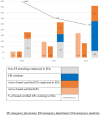The Evolution of Board-Certified Emergency Physicians and Staffing of Emergency Departments in Israel
- PMID: 39028245
- PMCID: PMC11254163
- DOI: 10.5811/westjem.18541
The Evolution of Board-Certified Emergency Physicians and Staffing of Emergency Departments in Israel
Abstract
Introduction: Emergency medicine (EM) was recognized as a specialty in Israel in 1999. Fifty-nine of the 234 (25%) attending physicians working in emergency departments (ED) nationwide in 2002 were board-certified emergency physicians (EP). A 2012 study revealed that 123/270 (45%) of ED attendings were EPs, and that there were 71 EM residents. The EPs primarily worked midweek morning shifts, leaving the EDs mostly staffed by other specialties. Our objective in this study was to re-evaluate the EP workforce in Israeli EDs and their employment status and satisfaction 10 years after the last study, which was conducted in 2012.
Methods: We performed a three-part, prospective cross-sectional study: 1) a survey, sent to all EDs in Israel, to assess the numbers, level of training, and specialties of physicians working in EDs; 2) an anonymous questionnaire, sent to EPs in Israel, to assess their demographics, training, employment, and work satisfaction; and 3) interviews of a convenience sample of EPs analyzed by a thematic approach.
Results: There were 266 board-certified EPs, 141 (53%) of whom were employed in EDs full-time or part-time. Sixty-two non-EPs also worked in EDs. The EPs were present in the EDs primarily during weekday morning shifts. There were 273 EM residents nationwide. A total of 101 questionnaires were completed and revealed that EPs working part-time in the ED worked fewer hours, received higher salaries, and had more years of experience compared to EPs working full time or not working in the ED. Satisfaction correlated only with working part time. Meaningful work, diversity, and rewarding relationships with patients and colleagues were major positive reasons for working in the ED. Feeling undervalued, carrying a heavy caseload, and having complicated relationships with other hospital departments were reasons against working in the ED.
Conclusion: Our study findings showed an increase in the number of trained and in-training EPs, and a decrease in the percentage of board-certified EPs who persevere in the EDs. Emergency medicine in Israel is at a crossroads: more physicians are choosing EM than a decade ago, but retention of board-certified EPs is a major concern, as it is worldwide. We recommend taking measures to maintain trained and experienced EPs working in the ED by allowing part-time ED positions, introducing dedicated academic time, and diversifying EP roles, functioning, and work routine.
Conflict of interest statement
Figures
References
-
- Drescher MJ, Aharonson-Daniel L, Savitsky B, et al. . A study of the workforce in emergency medicine in Israel: 2003. J Emerg Med. 2007;33(4):433–7. - PubMed
-
- Camargo CA, Jr, Ginde AA, Singer AH, et al. . Assessment of emergency physician workforce needs in the United States, 2005. Acad Emerg Med. 2008;15(12):1317–20. - PubMed
-
- Reiter M, Allen BW. The emergency medicine workforce: shortage resolving, future surplus expected. J Emerg Med. 2020;58(2):198–202. - PubMed
MeSH terms
LinkOut - more resources
Full Text Sources


